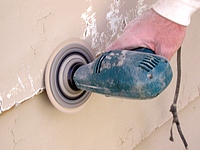 After wood trim and siding has been hand-scraped, it’s time to sand. Not all the paint present usually scrapes off. So you will need to sand the sharp edges left by the paint that stays behind. This is a process called feathering. It makes the finished paint job look much better!
After wood trim and siding has been hand-scraped, it’s time to sand. Not all the paint present usually scrapes off. So you will need to sand the sharp edges left by the paint that stays behind. This is a process called feathering. It makes the finished paint job look much better!
It would take far too much time to sand by hand, so painted exterior wood surfaces should be sanded with a power sander. Tackle large, flat areas with a disc or orbital sander. Use a trim or palm sander on more delicate surfaces or detailed areas.
Power Sanding Tips
- You want to use a light touch. Don’t press the sander into the wood.
- Work on a large area
- Keep the sander moving constantly. This will prevent gouging or wave patterns in the wood.
- Power sanding will often reveal places where paint is loose so sand the entire surface.
- When several layers of thick paint are present, first try a coarse sandpaper such as 30 grit. That can be followed up with a smoother 60 grit.
- If the wood is soft, use a finer sandpaper so you are less likely to make waves on the wood’s surface.
Keep in mind that disc sanders can take getting used to, so keep it light. Pressing down too hard tends to cause loss of control. The job may take longer but you’ll have full control.
Power sanding smooth Masonite siding is more difficult. Use a 60-grit or higher for best results. Keep in mind that some waves are unavoidable because Masonite is so soft. Again, keep it light and make sure the sander is always moving, especially on more brittle older Masonite.
Since power sander vibrations can break glass, it’s probably best to hand-sand around windows. First, scrape off loose paint, old caulking and putty. If the surface is rough or many flakes remain, use a course paper at first and follow with a smoother one.
If you sand the glass in a window by accident, it can result in permanent scratches. As part of your sanding prep work, you may want to mask the window off with paper or plastic. If you don’t have a mishap, you’ll be ready for painting.

The sanding treatment for stain is the same for indoor and outdoor surfaces. Prepare stained windows and doors by hand with fine paper. Remove clear finishes with 120-grit sandpaper and smooth the remaining stain with 180-grit. Hand-sanding is usually sufficient for stain.
Feathering is important on wood siding, due to its smoothness compared to other outdoor surfaces like brick. Surface irregularities on smooth siding are more noticeable.
One tool to have handy at the sanding stage for exterior wood is a wire brush, for an initial rough removal of stubborn raised areas before applying the more subtle technique of sanding.


